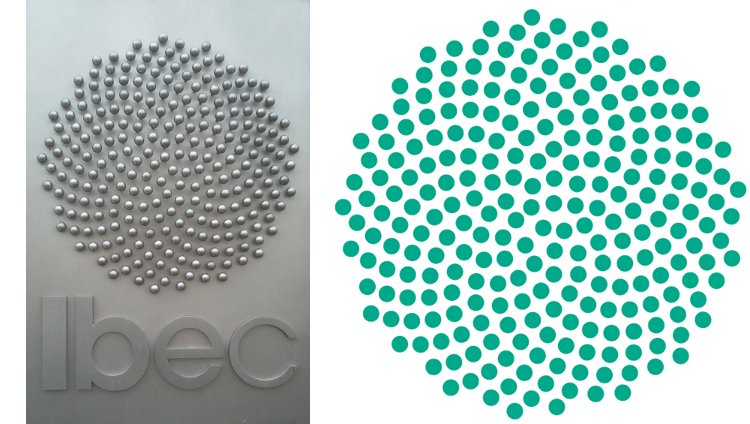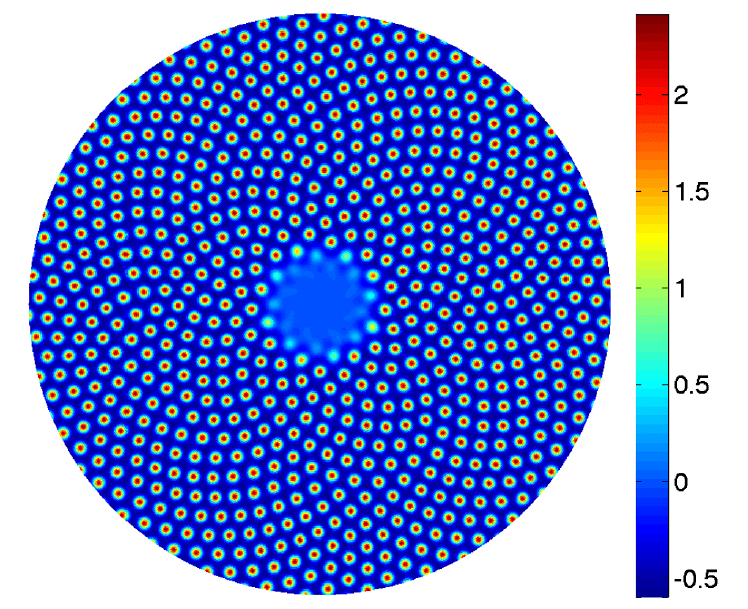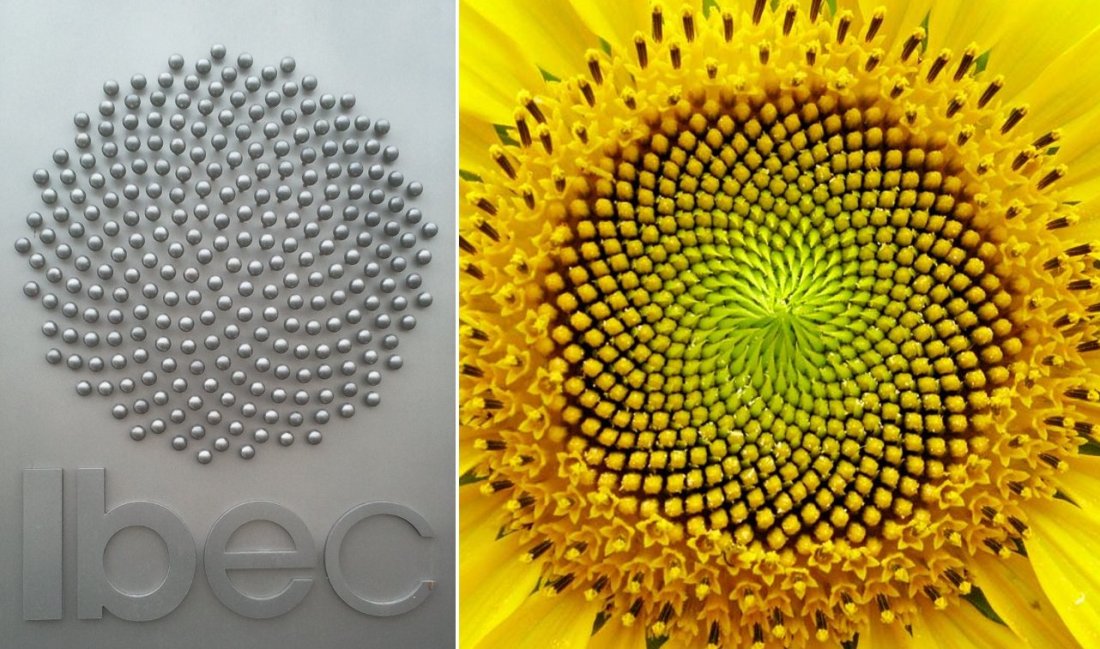The article in this week’s That’s Maths column in The Irish Times ( TM046 ) is about the maths behind the efficient packing of sunflowers and many other plants
Strolling along Baggot Street in Dublin recently, I noticed a plaque at the entrance to the Ibec head office. It showed a circular pattern of dots, reminiscent of the head of a sunflower. According to the Ibec website, “The spiral motif brings dynamism … and hints at Ibec’s member-centric ethos.” Wonderful! In fact, the pattern in the logo is vastly more interesting than this.

The logo is based on a pattern similar to that found in many flowers, most notably the sunflower. Counting the spirals visible towards the outer edge of the logo we find 34 clockwise and 21 counter-clockwise spirals. The numbers 21 and 34 are sequential entries in a famous number sequence called the Fibonacci sequence. This is no coincidence.
Fibonacci Numbers
A medieval mathematician, Leonardo of Pisa, usually known as Fibonacci, published a book, Liber Abaci (The Book of the Abacus) in 1202. While working in North Africa, he had come upon the decimal system of notation used by Arab mathematicians, and he introduced it to Europe in this book. In the same publication, while studying the way in which rabbit numbers increase, he described a sequence of numbers that bears his name and that has been a source of interest ever since.
The Fibonacci numbers are easily defined by an iterative process. We set F(0) = 0 and F(1) = 1 and let F(n) = F(n-1) + F(n-2) for n = 2, 3, 4, … . Thus, the first few numbers of the sequence are
0, 1, 1, 2, 3, 5, 8, 13, 21, 34, 55, 89, 144 and 233.
Each entry is the sum of the preceding two. As the values increase, the fractions formed by successive Fibonacci numbers – like 8/5, 13/8 and 21/13 – tend to a definite limit, about 1.618 or, more precisely,
φ = (1+√5)/2.
The number φ, called the golden number, was known to the Greeks through their study of proportions and the geometry of the regular pentagon.
If we divide a circle into two arcs whose ratio is the golden number, then the shorter arc subtends an angle φ of about 137.5º or, more precisely, (3-√5)π radians. This is called the golden angle.
Phyllotaxis
Phyllotaxis is the botanical study of the arrangement of phylla (leaves, petals, seeds, etc.) on plants. More than four centuries ago, the great astronomer Johannes Kepler noticed the spiral patterns on plants but no satisfactory explanation has emerged until recently.
Phyllotactic spirals form distinctive patterns in a variety of plants. For example, the leaves are often arranged in a helical pattern, as if winding around the stem. On pineapples, the hexagonal fruits fit together in interlocking families of helical spirals. The numbers of spirals are successive Fibonacci numbers like 5, 8 and 13. Sunflowers, which belong to the daisy family, usually have 55, 89 or 144 petals, and spiral patterns are evident in their seeds.
Biologists described long ago how the phylla are arranged, but explaining why these patterns form is much more difficult, and it is only recently that real progress has been made. Classical explanations of phyllotaxis appeal to optimisation principles, but do not account for how these optima are achieved.
A Simple Model
A simple mathematical description of the geometry of sunflower seed patterns was devised by Helmut Vogel (1979). He defined the positions of the seeds, using polar coordinates (r, θ), by
r(n) = √n and θ(n) = n φ
where φ ≈ 137.5º is the golden angle. Thus, as n increases by one, the position rotates through the golden angle and the radius increases as the square root of n. All points are on a curve called the generative spiral (r = √θ), a form of Fermat spiral which winds ever-tighter as it curls outwards.
Vogel’s model has been used to produce computer graphical representations of sunflowers, as it generates a pattern very similar to that seen on the flowers. If the angle is even one degree too small or too large, the pattern is broken. The centre pattern below results from the golden angle. The left and right patterns or for angles respectively one degree less than and greater than φ.

Vogel’s model is a neat characterisation but, of course, it does nothing to explain why such a pattern forms. The seeds of a sunflower are arranged in a manner that makes efficient use of the available space, giving maximum room for each seed to flourish and minimising wastage of space. As a new seed sprouts forth at the growth tip of a plant, it naturally tends to grow where there is most open space.
The new shoot pushes the old ones outward, resulting in a beautiful geometric arrangement. But why the golden angle? Recent research shows that the angle emerges naturally as a feature of the dynamics of plant growth.
Dynamics and Biochemistry
By introducing mechanics, we begin to explain the mechanisms that lead to the observed patterns. Some years ago, Dublin-born Alan Newell and Patrick Shipman at the University of Arizona applied elasticity theory to continuum models of growing cacti shoots. The formation of phylla was represented by buckling of the growing surface and the resulting pattern, corresponding to a minimum of the elastic energy, took the form of superimposed waves.
The observed pattern involved triad interactions, the interactions between three waves which satisfy criteria called resonance conditions. For a resonant triad, the wavenumbers of two waves must sum to that of the third, K1 + K2 = K3. This is similar to the recurrence relation for the Fibonacci numbers, F(n) = F(n-1) + F(n-2) providing a link between the wavenumbers and the arithmetic of the Fibonacci sequence.
But mechanics could not answer all the questions. For a more complete picture, biochemistry was needed. Recently, Newell and Matt Pennybacker (2013) have shown that the observed patterns emerge from a pattern-forming front arising from a combination of a biochemical and mechanical instabilities. Growth is stimulated by a plant hormone called auxin. The growth front is a solution of a nonlinear partial differential equation (PDE) for u, the concentration of auxin:
 The formation of primordial seeds is driven by high auxin concentrations. The growing seeds exert forces on each other, creating geometric patterns, and the geometry can trigger the production of auxin, leading to a feedback loop. Thus, biochemistry, mechanics and geometry all play a role in generating the observed patterns.
The formation of primordial seeds is driven by high auxin concentrations. The growing seeds exert forces on each other, creating geometric patterns, and the geometry can trigger the production of auxin, leading to a feedback loop. Thus, biochemistry, mechanics and geometry all play a role in generating the observed patterns.

The solutions generated by the PDE for auxin concentration were found to agree very closely with the patterns resulting from simple algorithms based on optimal packing strategies. This leads to the striking conclusion that nature can produce the most efficient arrangements by implementing self-organising pattern formation.
Sources
Newell, Alan C. and Matthew Pennybacker, 2013: Fibonacci patterns: common or rare? IUTAM Symposium on Understanding Common Aspects of Extreme Events in Fluids. Procedia IUTAM 9, 86 – 109.
Newell, Alan C. and P. Shipman, 2004: Phyllotactic patterns on plants. Phys. Rev. Lett 92, 168102.
Pennybacker, Matthew and Alan C. Newell, 2013: Phyllotaxis, Pushed Pattern-Forming Fronts, and Optimal Packing. Phys. Rev. Lett., 110, 248104. DOI: 10.1103/PhysRevLett.110.248104
Vogel, Helmut (1979). A better way to construct the sunflower head. Mathematical Biosciences 44 : 179–189.
Smith College website about phyllotaxis: http://www.math.smith.edu/phyllo/
Stewart, Ian, 2012: Mathematics of Life. Profile Books, 358pp.
* * * * * *
 Peter Lynch’s book about walking around the coastal counties of Ireland is now available as an ebook (at a very low price). Order now from amazon. For more information and photographs go to http://www.ramblingroundireland.com/
Peter Lynch’s book about walking around the coastal counties of Ireland is now available as an ebook (at a very low price). Order now from amazon. For more information and photographs go to http://www.ramblingroundireland.com/

